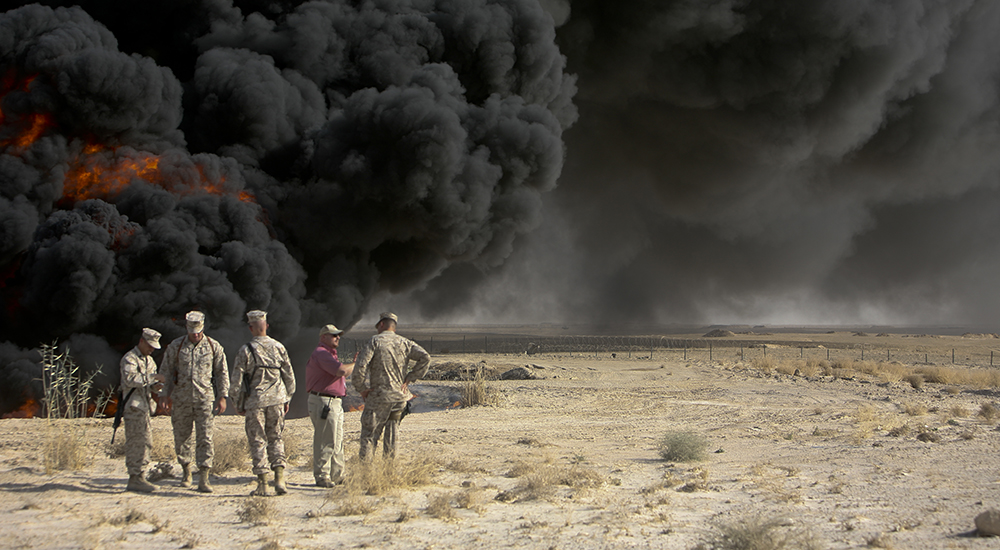Researchers may have found a possible link between blast exposure during military service and difficulty breathing and-or decreased exercise stamina among Burn Pit Registry participants. Researchers previously had found links between smoke and particulate matter and pulmonary symptoms, but the link between explosion blast waves and cardiopulmonary symptoms several years after exposure is new.
This discovery was made possible by the Airborne Hazards and Open Burn Pit Registry. Analyzing nearly 43,000 records in the registry entered between June 2014 and July 2015, researchers sought to identify connections between current health symptoms and participants’ exposure to and distance from IED blasts.
”Not only is this finding of an association between blast exposure and cardiopulmonary symptoms unique to Veterans, it’s unique to the research field and something that has not previously been demonstrated,” said Dr. Michael Falvo, a research physiologist at VA’s War Related Illness and Injury Study Center in East Orange, NJ, and a key researcher on this study.
Despite the interesting findings, the study has several limitations. Two such limitations are the use of self-reported data, because it is possible that participants may exaggerate or misremember their experiences, and the use of self-selected participants, because those who choose to participate may have different experiences compared to all possible participants. Additional research will be needed to confirm the findings from this study.
“What this registry-related research has done is provide the foundation and rationale to explore this question further using a more objective approach,” said Falvo.
Link found between exposure and respiratory symptoms
“In addition to the scientific contribution of this paper, it and other analyses show Veterans and their providers that the time they spend completing the online questionnaire can result in important findings,” added Dr. Drew Helmer, director of VA’s War Related Illness and Injury Study Center in New Jersey and principal investigator on this study .
VA researchers also used Burn Pit Registry data to learn about the effects of burn pit emissions on respiratory and cardiovascular health. Looking at 4,343 registry participants who completed the questionnaire by April 30, 2015, they found a link between pit emissions exposure and self-reported respiratory symptoms.
Researchers will do more studies with data from burn pit registry. By the end of April 2018, more than 140,000 Veterans and Servicemembers had signed up for the burn pit registry. “We appreciate Veterans’ willingness to provide this information and want to put it to good use,” said Helmer.
The registry is for Veterans and Servicemembers who served in the Southwest Asia theater of operations after August 2, 1990, or Afghanistan or Djibouti after September 11, 2001. Learn more about the registry, check your eligibility to participate and sign up to begin contributing to research efforts.

Topics in this story
More Stories
The Medical Foster Home program offers Veterans an alternative to nursing homes.
Watch the Under Secretary for Health and a panel of experts discuss VA Health Connect tele-emergency care.
The 2024 National Veteran Suicide Prevention Annual Report provides the foundation for VA’s suicide prevention programs and initiatives.







And yet Ft. McClellan Veterans keep getting denied VA healthcare. The airborne PCB’s got in to the air, ground and water for decades. The town of Anniston Alabama won a lawsuit against Monsanto in 2003 for $700 Million dollars, but somehow Ft. McClellan was immune to this exposure? I don’t think so. Then to top it off, Ft. McClellan was also contaminated with Cobalt 60, Cesium 137, Sulfur Mustard Gas, VX Nerve Agent and other types of chemical and biological agents. The absurdity of the VA to pick & choose which Veterans they want to take care of and which Veterans they decide to ignore is just unacceptable.
https://www.publichealth.va.gov/exposures/fort-mcclellan/
For now the only camp that is getting this attention is Camp Lejeune, and believe me… there are more than just 2 bases that had problems like this.
.
.https://www.publicintegrity.org/2017/08/18/21105/military-bases-contamination-will-affect-water-generations
and we have issues at our military bases around the world… Philippines, Japan, Korea and more. Many of these bases allow for Military Dependents to accompany and put them at the same danger… Folks… look for this to drag out like the “Agent Orange Issue” which lead to the QUEEN of the issue…Maude DeVictor, to be fired from the Chicago VA, when she identified the first correlation of Dioxin use in South East Asia and various illnesses…especially cancer. She opened her mouth to Superiors and was shut down.
Response provided by VHA: The Ft. McClellan environment and possible exposures have been investigated. There are currently no adverse health conditions associated with service at Ft. McClellan.
I was Desert Storm and Desert Shield during the oil well burning! There was a day or two that in the middle of the day that you needed a flash light to see because the smoke was so thick!!
I never saw the form or questions that were being asked. Did the report focus on short or long term exposure to ” burn pits”.
How was the short term exposure classified. A lot of vets were exposed to explosions, fire and smoke due to land mines and
other IUDs. Was this part of the study.
Thanks,
Ron Blansett
Response provided by VHA: For the most recent study, VA looked at the answers to the registry questions: “Do you currently have any of the following symptoms?” and an affirmative response to the question “Were you ever close enough to feel the blast from an IED (improvised explosive device) or other explosive device?”
I am curious to learn if the “decreased exercise stamina” condition in the opening statement applies to me and if any link has been found between the burn pits and tumors. I spent just over five months (12/1990-5/1991) in the Persian Gulf War of which one whole month was in Iraq not too far from the burn pits. My unit must have been closer than we thought because on one day, we stepped out of our communications vans during midday and it appeared as midnight. In Jan. 2011, I had a tumor behind my left ear removed resulting in some decreased facial functionality on that side. Tumors are not common in my family. So, ever since I heard about this registry and registered, I have been awaiting research results on this. Thank you. USAR, Florida.
Response provided by VHA: We are sorry to hear about your tumor. At this time, no association has been found between tumors and burn pits, but VA is still involved in research on health outcomes and burn pit exposures. For specific questions about your health, you may wish to talk to your health care provider. One benefit of participating in the burn pit registry is that after completing the questionnaire you can have a free VA health exam to learn more about your health concerns.
Most base camps in Vietnam had numerous burn pits…any updates on that situation?
I have been bringing up inclusion of Vietnam Veterans into this study. We burned everything from Human excrement to trash that included plastics, treated/coated wood and fuel, to even human remains and body parts in a MASH environment. We were never issued any protective gear, usually just diesel fuel, a stick and means to light it up. Many fire bases we left behind were destroyed by blowing up facilities or burning everything we couldn’t move. Vietnam Veterans should be included. That being said, I have pushed for this day one. I write/call Legislators but it falls on DEAF ears or uncaring hearts, because…to this day…NOT ONE reply to my comments for OR against. It is like the Vietnam Vet is a tertiary consideration …yet again.
Response provided by VHA: As mandated by Congress, the Airborne Hazards and Open Burn Pit Registry focuses exclusively on exposures during service in Southeast Asia, Djibouti, or Afghanistan since July 1990. The Agent Orange Registry for Vietnam Veterans can record other environmental concerns of Vietnam Veterans.
May 31, 2018. Has this information been collected on US burn pits and south east Asia burn pits. I worked with aviation fuels. Charleston AFB, U-TAPAO Thailnd and SanBernadino AFB all had pits used for “training of firemen and disposal of any petroleum, oil and lubricants plus anything that would burn in the process. Smoke and smell of this would gag a maggot. Let me know. Thank you. Bill Zedicher, USAF & Nebraskan.
Response provided by VHA: The Airborne Hazards and Open Burn Pit Registry is maintained for exposures during service in Southeast Asia, Djibouti, or Afghanistan since July 1990. VA is doing other research regarding fuel exposures.